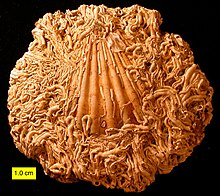| Revision as of 01:11, 21 February 2008 editVsmith (talk | contribs)Administrators273,134 edits Undid revision 192806471 by 132.187.57.127 (talk)rmv spam← Previous edit | Revision as of 04:32, 14 April 2008 edit undo74.193.176.147 (talk)No edit summaryNext edit → | ||
| Line 10: | Line 10: | ||
| During the late ], taphonomic data began to be applied to other paleontological subfields such as ], ], ] (the study of ]) and ]. By coming to understand the ] and ] implications of observed taphonomic patterns, paleontologists have been able to provide new and meaningful interpretations and correlations that would have otherwise remained obscure in the ]. | During the late ], taphonomic data began to be applied to other paleontological subfields such as ], ], ] (the study of ]) and ]. By coming to understand the ] and ] implications of observed taphonomic patterns, paleontologists have been able to provide new and meaningful interpretations and correlations that would have otherwise remained obscure in the ]. | ||
| ] ] in Imperial-Diamond cave (]).]] | ] ] in Imperial-Diamond cave (]).]] | ||
| ] study taphonomic processes in order to determine how plant and animal (as well as human) remains accumulate and differentially preserve within archaeological sites. This is critical to determining whether these remains are associated with human activity. In addition, taphonomic processes may alter biological remains after they are deposited at a site. Some remains survive better than others over time, and can therefore bias the excavated collection. | ] study taphonomic processes in order to determine how plant and animal (as well as human) remains accumulate and differentially preserve within archaeological sites. This is critical to determining whether these remains are associated with human activity. In addition, taphonomic processes may alter biological remains after they are deposited at a site. Some remains survive better than others over time, and can therefore bias the excavated collection. | ||
Revision as of 04:32, 14 April 2008


Taphonomy is the study of a decaying organism over time. The term taphonomy, (from the Greek taphos meaning burial, and nomos meaning law), was introduced to paleontology in 1940 by Russian scientist, Ivan Efremov, to describe the study of the transition of remains, parts, or products of organisms, from the biosphere, to the lithosphere, i.e. the creation of fossil assemblages, (e.g. see Shipman 1981 p.5-6, Greenwood 1991, Lyman 1994).
Taphonomists study such phenomena as biostratinomy, decomposition, diagenesis, and encrustation and bioerosion by sclerobionts (see Taylor and Wilson, 2003).
The primary motivation behind the study of taphonomy is to better understand biases present in the fossil record. Fossils are ubiquitous in sedimentary rocks, yet paleontologists cannot draw the most accurate conclusions about the lives and ecology of the fossilized organisms without knowing about the processes involved in their fossilization. For example, if a fossil assemblage contains more of one type of fossil than another, one can either infer that that organism was present in greater numbers, or that its remains are more resistant to decomposition.
During the late 20th century, taphonomic data began to be applied to other paleontological subfields such as behavioral paleobiology, paleoceanography, ichnology (the study of trace fossils) and biostratigraphy. By coming to understand the oceanographic and ethological implications of observed taphonomic patterns, paleontologists have been able to provide new and meaningful interpretations and correlations that would have otherwise remained obscure in the fossil record.

Archaeologists study taphonomic processes in order to determine how plant and animal (as well as human) remains accumulate and differentially preserve within archaeological sites. This is critical to determining whether these remains are associated with human activity. In addition, taphonomic processes may alter biological remains after they are deposited at a site. Some remains survive better than others over time, and can therefore bias the excavated collection.
Within archaeology the term taphonomy has now been wrongly expanded from just plant and animal remains to include all parts of the archaeological record - from how buildings collapse over time to form the archaeologically found features to the degradation of excavated items whilst housed within a store. This is commonly referred to as site formation processes. The example given in the original text suggested that a study at the University of Bradford looked at the increased damage to the stored skeletal collections over time due to their use for study by doctoral and post-doctoral students, i.e. the modification of the human remains. The study lead to a standardized method of packing the remains to minimize damage. The example is correct but most pathological researchers would argue that taphonomy solely applies to the death, decay, and modification process of living organism..
Experimental taphonomy testing usually consists of exposing the remains of organisms to various altering processes, and then examining the effects of the exposure.
References
- Efremov, I. A. (1940), Taphonomy: a new branch of paleontology. Pan-American Geology 74:81-93.
- Greenwood, D. R. (1991), The taphonomy of plant macrofossils. In, Donovan, S. K. (Ed.), The processes of fossilisation, pp.141-169. Belhaven Press.
- Lyman, R. L. (1994), Vertebrate Taphonomy. Cambridge University Press.
- Shipman, P. (1981), Life history of a fossil: An introduction to taphonomy and paleoecology. Harvard University Press.
- Taylor, P. D. and Wilson, M. A. (2003), Palaeoecology and evolution of marine hard substrate communities. Earth-Science Reviews 62:1-103.
External links
- The Shelf and Slope Experimental Taphonomy Initiative is the first long-term large-scale deployment and re-collection of organism remains on the sea floor.
- The Journal of Taphonomy
- Bioerosion Website at The College of Wooster
- Comprehensive bioerosion bibliography compiled by Mark A. Wilson